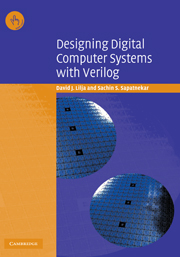Book contents
- Frontmatter
- Contents
- Preface
- 1 Controlling complexity
- 2 A Verilogical place to start
- 3 Defining the instruction set architecture
- 4 Algorithmic behavioral modeling
- 5 Building an assembler for VeSPA
- 6 Pipelining
- 7 Implementation of the pipelined processor
- 8 Verification
- A The VeSPA instruction set architecture (ISA)
- B The VASM assembler
- Index
- VeSPA Instruction Set
3 - Defining the instruction set architecture
Published online by Cambridge University Press: 31 October 2009
- Frontmatter
- Contents
- Preface
- 1 Controlling complexity
- 2 A Verilogical place to start
- 3 Defining the instruction set architecture
- 4 Algorithmic behavioral modeling
- 5 Building an assembler for VeSPA
- 6 Pipelining
- 7 Implementation of the pipelined processor
- 8 Verification
- A The VeSPA instruction set architecture (ISA)
- B The VASM assembler
- Index
- VeSPA Instruction Set
Summary
It's like building a bridge. Once the main lines of the structure are right, then the details miraculously fit. The problem is the overall design.
Freeman Dyson in Freeman Dyson: Mathematician, Physicist, and Writer, Interview with Donald J. Albers, The College Mathematics Journal, 25, No. 1, January 1994.Now that we have been introduced to the fundamentals of Verilog, we make a slight change in course to return to the top level of the design flow shown previously in Figure 1.2. In particular, we now discuss the process by which we define the instruction set of a new processor.
The instruction set architecture (ISA) of a processor defines all of the instructions available in the processor plus the storage elements that are accessible to the assembly language programmer. The contents of these storage elements, plus a few more that may not be directly accessible to the programmer, comprise the processor's state.
In this chapter, we show how the ISA of a complete processor, which we call the Very Small Processor Architecture, or VeSPA for short, is defined, refined, and ultimately specified. This processor is quite simple, with only slightly more than a dozen instructions. However, it is a complete processor capable of executing programs written in a high-level language compiled with an appropriate compiler. We use this processor throughout the remainder of this text as a vehicle for demonstrating the entire processor design process when using the Verilog hardware description language.
Instruction set design
The design of an instruction set for a new processor is more of an art than a science.
- Type
- Chapter
- Information
- Designing Digital Computer Systems with Verilog , pp. 32 - 57Publisher: Cambridge University PressPrint publication year: 2004



